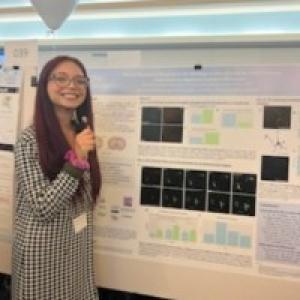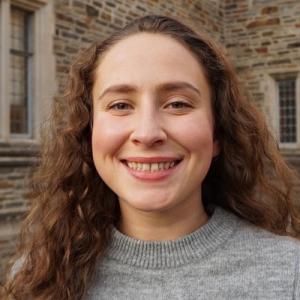About Us
Our lab brings together basic and clinical science approaches towards the goal of improving memory and cognitive ability in individuals affected by neurological disorders. The premise guiding our work is that while aging is associated with well-known declines in certain cognitions, much of our ability to make sense of the world remains preserved, and this semantic scaffold can serve as a basis for successful interventions for age-related memory decline. Our central research goal has been to identify the mechanisms promoting healthy cognitive functioning in both normal aging and dementia and explore new neuromodulatory technologies that help us exploit these mechanisms to improve cognitive functioning. Projects in the lab use imaging-based network analysis techniques to assess structural and functional changes in the aging brain, and our latest research has involved using neuromodulatory devices to explore both clinical and research applications to show effective modulation of memory networks in younger and older adults
We are located in Durham, North Carolina and are a part of both the Duke Neurology Department and the Center for Cognitive Neuroscience at Duke University.
Our Research
Our primary focus is investigating white matter changes in the aging brain, examining representations of semantic memory networks, and probing the effects of TMS on older adults. We are located in Durham, North Carolina and are a part of the Department of Neurology and the Center for Cognitive Neuroscience at Duke University.
White matter changes in Normal Aging and AD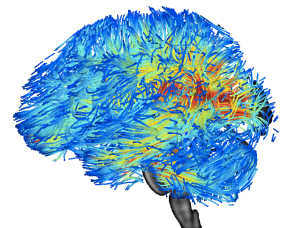
The integrity of cerebral white matter is critical for efficient cognitive functioning. Our lab finds interesting ways to use diffusion weighted imaging (DWI) to ask novel questions about how white matter supports healthy cognitive function. DWI measures the directional displacement of molecular water and as a result can characterize the properties of white matter that combine to restrict diffusivity in a spatially coherent manner.
Semantic Memory Networks
Our ability to form abstract representations of objects in semantic memory is crucial to language and thought. The utility of this information relies both on the representations of sensory-motor feature knowledge stored in long-term memory and the executive processes required to retrieve, manipulate, and evaluate this semantic knowledge in a task-relevant manner.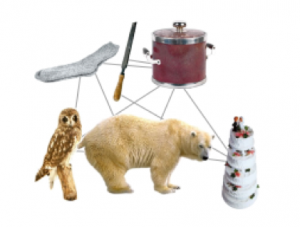
The explosion of fMRI-based representational similarity analyses (RSA) have helped to elucidate the functional correlates of object representation. What is less clear is how memory influences and is influenced by the organization of complex representational structures. We have shown how feature similarity across a wide set of items predicts distinct forms of episodic memory performance. Subjects named everyday objects during fMRI and returned a day later to make old/new judgments on either conceptual (old/new words) or perceptual information (same/exemplar images).
Brain Stimulation Effects on Networks in Aging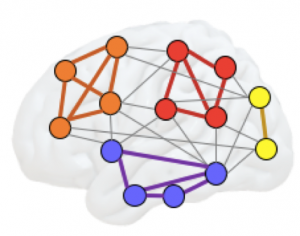
As populations experience a rapid growth of its older segments, a major neuroscientific research goal is to increase our knowledge about mechanisms that sustain healthy brain aging, as well as to promote projects that may help to prevent neuropsychiatric age-associated disorders. Over the past few decades, transcranial magnetic stimulation (TMS) has developed into a powerful tool to causally establish brain-behavior relationships. The goal of our work here is to understand how differences in stimulation parameters map onto these global network dynamics, or how cognitive states can be selectively targeted using dynamic spatiotemporal signals distributed over large-scale networks of the brain.
Our Team
Lab Alumni
- Margaret (Mags) McAllister - Clinical Research Coordinator
- Lifu Deng - Graduate Student
- JT Galla - Graduate Student
- Amanda Szymanski – Research Technician
- Daisy Banta - Research Technician
- Courtney Crowell - Research Technician
- Devi Lakhlani - Undergraduate Researcher
- Mariam Hovhannisyan - Research Technician
- Olga Lucia Gamboa Arana, PhD - Post Doctorate
Publications
Preprints
Hovhannisyan M, Geib B, Clarke A, Cicchinelli R, Cabeza R, Davis SW. in review. The Visual and Semantic Features that Predict Object Memory: Concept Property Norms for 1000 Object Images. preprint: https://psyarxiv.com/nqmjt/
Cooper RA, Kurkela KA, Davis SW, Ritchey M. in review. Mapping the organization and dynamics of the posterior medial network during movie watching. preprint: https://www.biorxiv.org/content/10.1101/2020.10.21.348953v1.
Beynel L, Campbell E, Naclerio N, Galla JT, Ghosal A, Michael AM, Kimbrel NA, Davis SW, Appelbaum LG. in review. The effect of functionally-guided-connectivity-based rTMS on amygdala activation
. preprint: https://www.biorxiv.org/content/10.1101/2020.10.13.338483v1.
Journal Articles
2020
Davis SW, Geib BR, Wing EA, Wang W-C, Hovhannisyan M, Monge Z, Cabeza R. Visual and semantic representations predict subsequent memory in perceptual and conceptual memory tests. 2020. Cerebral Cortex.
Beynel L*, Deng L*, Crowell CA, Dannhauer M, Palmer H, Hilbig SA, Peterchev AV, Luber B, Lisanby SH, Cabeza R, Appelbaum LG, Davis SW. 2020. Structural Controllability Predicts Functional Patterns and Brain Stimulation Benefits Associated with Working Memory.” J Neurosci 40(35): 6770-6778.
Cabeza R, Becker M, Davis SW. Are the hippocampus and its network necessary for creativity? 2020. PNAS. 117 (25), 13870-13872.
Davis SW*, Crowell CA*, Beynel L, Deng L, Lakhlani D, Hilbig SA, Palmer H, Peterchev A, Luber BL, Lisanby SH, Appelbaum LG, Cabeza R. 2020. Older adults benefit from more widespread brain network integration during working memory. Neuroimage, 116959.
Gamboa OL, Brito A, Abzug Z, D’Arbeloff T, Beynel L, Wing EA, Dannhauer M, Palmer H, Hilbig SA, Crowell CA, Liu S, Donaldson R, Cabeza R, Davis SW, Peterchev AV, Sommer MA, Appelbaum LG. 2020. Application of long-interval paried-pulse transcranial magnetic stimulation to motion-sensitive visual cortex does not lead to changes in motion discrimination. Neuroscience Letters.
Beynel L*, Davis SW*, Crowell CA, Hilbig SA, Dannhauer M, Lim W, Palmer H , Hilbig SA, Brito A, Hile C, Luber B, Lisanby SH, Peterchev AV, Cabeza R, Appelbaum LG. 2020. Site-specific effects of online rTMS during a working memory task in healthy older adults. Brain Sciences. 10 (5), 255.
Wing EA, Geib BR, Wang WC, Monge Z, Davis SW, Cabeza R. 2020. Cortical overlap and cortica-hippocampal interactions predict subsequent true and false memory. Journal of Neuroscience. 40 (9), 1920-1930.
2019
Beynel L, Appelbaum LG, Luber B, Crowell CA, Hilbig SA, Lim W, Nguyen D, Chrapliwy NA, Davis SW, Cabeza R, Lisanby SH, Deng Z. 2019. Effects of online repetitive transcranial magnetic stimulation (TMS) on cognitive processing: A meta-analysis and recommendations for future studies. Neuroscience and Behavioral Reviews. 107, 45-58.
Beynel L, Davis SW, Crowell CA, Hilbig SA, Lim W, Nguyen D Palmer H , Brito A, Peterchev AV, Luber B, Lisanby SH, Cabeza R, Appelbaum LG. 2019. Online repetitive transcranial magnetic stimulation during working memory in younger and older adults: A randomized within-subject comparison. 2019. PLoS one. 14 (3), e0213707.
2018
Wang W, Wing EA, Murphy DLK, Luber B, Lisanby SH, Cabeza R, Davis SW. 2018. Excitatory TMS Boosts Memory Representations.Cognitive Neuroscience.
Davis SW, Fink, TA, Hayes SA, Cabeza R. Cooperative Contributions of Structural and Functional Connectivity to Successful Memory in Aging. 2018. Network Neuroscience.
Davis SW, Crowell CA, Beynel L, Deng L, Lakhlani D, Hilbig SA, Lim W, Nguyen D, Palmer H, Peterchev A, Luber BL, Lisanby SH, Appelbaum LG, Cabeza R. 2018. Complementary topology of maintenance and manipulation brain networks in working memory.
Davis SW*, Wing EA*, Cabeza R. Contributions of the ventral parietal cortex to declarative memory. 2018. In: Vallar G and Coslett HB, eds. Handbook of Clinical Neurology: The Parietal Lobe. San Diego: Elsevier BV, 2018.
2017
Davis SW, Murphy DM, Luber BL, Lisanby SH, Cabeza R. Frequency-specific neuromodulation of local and distant connectivity in aging and episodic memory function. 2017. Human Brain Mapping.
2016
Davis SW, Stanley ML, Moscovitch M, Cabeze R. Resting-state networks do not determine cognitive function networks. 2016. Language, Cognition, and Neuroscience. 32, 6: 669-673.
2015
Davis SW & Cabeza R. Cross-Hemispheric Collaboration and Segregation Associated with Task Difficulty as Revealed by Structural and Functional Connectivity. 2015. Journal of Neuroscience. 35: 8191-8200.
2014
Kievet RA, Davis SW, Mitchell DJ, Taylor JR, Duncan J, Henson RNA. 2014. Distinct aspects of frontal lobe structure mediate age-related differences in fluid intelligence and multitasking. in press. Nature Communications.
Madden DJ, Parks EL, Davis SW, Diaz MT, Potter GG, Chou YH, Chen NK, Cabeza R. 2014. Age mediation of frontoparietal activation during visual feature search. NeuroImage, doi: 10.1016/j.neuroimage.2014.07.053.
Davis SW, Zhuang J, Wright P, Tyler LK. Task-related modulation of neurocognitive networks in aging. 2014. Neuropsychologia. 63:107-15.
Hall SA, Rubin DC, Miles A, Davis SW, Wing EA, Cabeza R, Berntsen D. 2014. The Neural Basis of Involuntary Episodic Memories. J Cogn Neurosci.
2013
Daselaar SM, Davis SW, Iyengar V, Eklund K, Hayes SM, Cabeza R. 2013. Less Wiring, More Firing: Low-Performing Older Adults Compensate for Impaired White Matter with Greater Neural Activity. Cerebral Cortex.
Whalley MG, Kroes MC, Huntley Z, Rugg MD, Davis SW, Brewin CR. 2013. An fMRI investigation of posttraumatic flashbacks. Brain Cogn. 81:151-9.
2012
Cantlon JF, Davis SW, Libertus M, Brannon E.M, and Pelphrey KA. 2012. Inter-parietal white matter development predicts numerical performance in young children. Learning and Individual Differences. 21, 672-680.
2011
Davis SW, Kragel JE, Madden DJ, Cabeza R. 2011. The architecture of cross-hemispheric communication in aging: Linking behavior to structural and functional connectivity. Cerebral Cortex, 21(4), 231-42.
2010
Madden DJ, Costello MC, Dennis NA, Davis SW, Shepler AM, Spaniol J, Bucur B, Cabeza R. 2010. Adult age differences in functional connectivity during executive control. Neuroimage, 15, 643-657.
2009
Davis SW, Dennis, NA, Buchler, NEG, Madden DJ, White LE, Cabeza R. 2009. Assessing the effects of age on long association fibers using DTI tractography. NeuroImage. 46, 530-541.
Madden, D.J, Spaniol, J, Costello, M, Bucur, B, White LE, Cabeza, R, Davis, S.W, Dennis, N.A, Provenzale, J.M, Huettel, S.A. 2009. Cerebral white matter integrity mediates adult age differences in cognitive performance. Journal of Cognitive Neuroscience. 21, 289-302.
2008
Davis SW, Dennis NA, Daselaar, SM, Fleck, ME, Cabeza, R. 2008. Que PASA? The posterior-anterior shift in aging. Cerebral Cortex. 18(5), 1201-1209. *Reviewed by Faculty of 1000, Medicine: Must Read
2007
Leow AD, Yanovsky I, Chiang MC, Lee AD, Klunder AD, Lu A, Becker JT, Davis SW, Toga AW, Thompson PM. 2007. Statistical properties of Jacobian maps and the realization of unbiased large-deformation nonlinear image registration. IEEE Trans Med Imaging. 26(6), 822-832.
2006
Simons JS, Davis SW, Gilbert SJ, Frith CD, Burgess PW. 2006. Discriminating imagined from perceived information engages brain areas implicated in schizophrenia. NeuroImage. 32, 696-703.
Becker JT, Davis SW, Hiyashi KM, Meltzer CC, Toga AW, Lopez OL, Thompson PM. 2006. Three-dimensional patterns of hippocampal atrophy in mild cognitive impairment. Archives of Neurology. 63, 90-101.
2005
Carmichael OT, Aizenstein HA, Davis SW, Becker JT, Thompson PM, Meltzer CC, Liu Y. 2005. Atlas-based hippocampus segmentation in Alzheimer’s disease and mild cognitive impairment. NeuroImage. 27, 979-990.
Presentations
Cross-hemispheric Connectivity Benefits Cognition in Normal Aging & MCI (March 2020). Presented at the Cognitive Neuroscience Society 2020 Virtual Meeting.
Modulation of brain activation and functional connectivity during motion perception with concurrent TMS (March 2020) Presented at the Cognitive Neuroscience Society 2020 Virtual Meeting.
The Visual and Semantic Features that Predict Object Memory (March 2019). Presented at the North Carolina Cognition Conference. Raleigh, NC
Talks
APA San Francisco 2018
Come see my talk,TMS for Identifying Compensatory Patterns in Aging, at the American Psychological Association conference, Thursday @ 10am (Moscone Center, Room 156, Upper Mezzanine – South Building), in a session on Transcranial Magnetic Stimulation as an Emerging Clinical and Research Tool.

Carolina Networks Research Group
November 8
Visualizing Dynamic Functional Connectivity (Speaker: Guorong Wu)
September 13th, 2017
Defining Architecture with DWI (Speaker: S
Collaborators
Cabeza Lab (Duke University)
Opti Lab (Duke University School of Medicine)
Cam-CAN (Cambridge University)
Rogier Kievit (Cambridge University)
Karen Campbell (Cambridge University)
Duke Institute for Brain Sciences (Duke’s umbrella organization for neuroscience-related research)
Bryan Alzheimer's Disease Research Center (Bryan ADRC)
Resources
The DinoLab Object Database
This database represents normative visual and semantic feature information on 1000 object images, selected to represent a wide range of real-world concepts organized by category.
Information includes:
- Regularized (300×300) jpegs of all 1000 objects in the database
- Normative semantic features, based on data collected on Amazon Turk
- Memorability information for each item, for both lexical and pictoral recognition memory tests
Software
- Our lab github.
Brains
- Jonathan Peelle knows what it’s like to learn fMRI and what your reading list should be.
- Jeanette Mumford’s tumblr or YouTube feed are the best things on either of those websites.
- The Wager/Lindquist Coursera course.
- Maureen Ritchey’s MTL atlas.
Grants
- A couple helpful GoogleSheet describing awards for Early Career Investigators.
- The NIH Funding twitter feed.
Local Duke Stuff
- The always helpful BIAC wiki.
